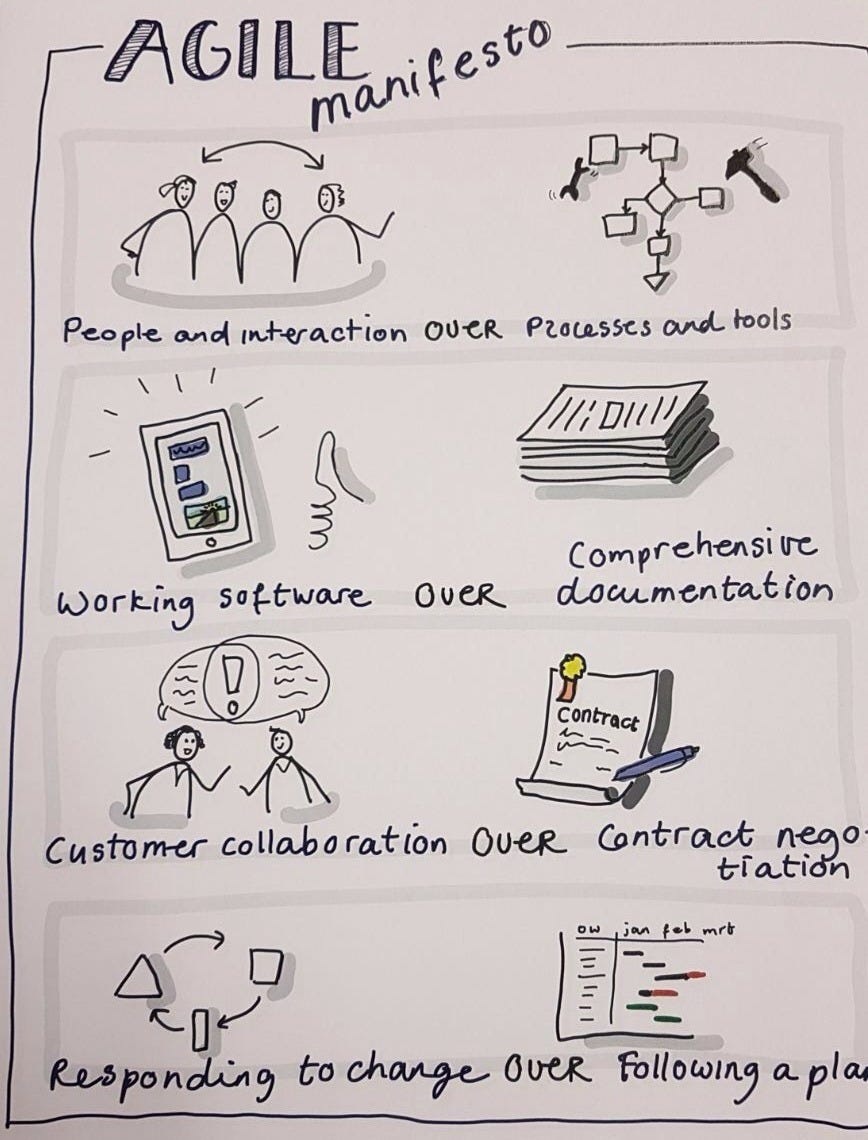How Modern Government Teams Are Redesigning the Way Work Gets Done
A conversation with Mark Lerner on small shifts that are leading to big results, even in a bureaucracy.
(9 min read)
When government works well, it is one of the most morally ambitious, impactful, and awe-inspiring systems we have. It touches nearly every aspect of people’s lives and has the potential to address some of the greatest challenges of our time. But even the most mission-driven public servant leaders are struggling inside systems that no longer reflect how great work gets done.
Across agencies, the symptoms are familiar. Endless reorgs with little payoff. Senior talent walking out the door. Performance systems that promise clarity but rarely deliver it. And teams that care deeply, but feel like they’re spinning in circles, feeling overwhelmed, unheard, duplicating efforts, and quietly burning out.
It doesn’t have to be this way. I’ve seen what’s possible when teams are trusted, aligned, and equipped to work differently. So has Mark Lerner, deputy director of Technologists for the Public Good, who’s spent years helping government agencies across local, state, and federal levels shift toward modern ways of working. This article is about what we’ve learned and what you can try, starting now.
👋 Hey, it’s Jess. Welcome to my weekly newsletter, Thought(ful) Leaders, where I share practical tools and frameworks, share research, and interview thoughtful leaders on the future of work.
⛑️ Work with me for 1:1 executive coaching or book a workshop for your team.
If you’re not a subscriber yet, catch up on my latest articles from last month:
Subscribe to get access to these posts, and all future posts.
Trust Is Built Through Visible, Shared Norms
Mark has led digital innovation efforts inside agencies like the US Digital Service (USDS), supporting teams at the US Citizenship and Immigration Services (USCIS), where modern technology was in place, but transparency and trust were still shaky. His experiences, along with his writing at the Belfer Center and Partnership for Public Service, offer powerful lessons for any team looking to work differently.
One of the most important takeaways from our recent conversation was this: trust is not just a personality or cultural trait. It is a system.
At USDR, where Mark and I met, we did not build trust quickly because we all knew each other. We built trust because we agreed to norms that made our work visible and ensured we were accountable to one another. When someone said, "I got this," we knew what came next. A Slack channel spun up. Airtable documentation showed up. The work became real, and visible, fast. And if it didn’t, that was a signal, not a failure of character, but a moment to check in, reassign, and keep things moving.
That kind of clarity is not magic. It is the result of intentional design. As Mark said, "Transparency doesn't mean one more meeting or one more report. It means people know what to expect and where to find the truth."
This principle aligns closely with the Agile Manifesto, a foundational set of values for modern teams. Agile values “individuals and interactions over processes and tools” and encourages working software, customer collaboration, and responsiveness to change over rigid planning. In public sector terms, that means building systems where collaboration and iteration are not just possible but expected. (Agile Manifesto)
“You can’t just ask teams to be faster or more agile, you have to redesign the environment around them to make it possible.”
This approach isn’t about doing more or scaling faster. It’s about doing what matters, with more ease, alignment, and humanity, even in the most complex public institutions.
When Well-Meaning Design Undermines the Work
So what breaks that clarity? In one example from his time at USCIS, Mark described a well-meaning procurement structure that assigned multiple contractors to the same project to drive performance. In theory, it encouraged positive competition. In practice, it created silos and discouraged transparency. People hid risks because they were afraid of losing work to other contractors.
The process of overseeing these contractor teams and their work became more of a bloated reporting activity rather than an iterative learning and adapting process.
To fix this, his team introduced small but radical changes. Instead of one massive quarterly meeting with 100-slide decks and compliance observers, they piloted a tighter format focused on the actual questions decision-makers needed answered. Key stakeholders got more clarity, not less. The team saved weeks of prep time. And, critically, they were able to shorten the feedback loop between doing the work and adjusting course.
This story reinforces a core theme in Mark’s writing: outcomes matter more than process. As he wrote in Leading with Modern Ways of Working, "Public sector teams should focus on improving outcomes over protecting bureaucratic processes."
Five Practical Shifts You Can Try Right Now
If you are leading a project today and want to bring these ideas into your organization, here are a few specific, low-lift shifts you can try:
Pilot New Ways To Make Faster Decisions
Find a recurring process where things slow down due to handoffs or approvals. Try a new cadence: a live document review instead of a quarterly meeting, or a weekly working session instead of multi-stage sign-offs. Call it a pilot. Everyone loves a pilot.
Be Ruthless About Open Collaboration
Mark emphasized that having standards around using basic collaboration tools like Google Docs or Microsoft 365 are one of the simplest ways to build transparency and reduce duplicating effort. But it only works if everyone is collaborating in the same doc in the same ways. No emailing attachments. No creating side versions. Set norms around using comments, suggested edits, and version history to get work done more transparently and faster.
Reward Follow-Through with Smart Visual Management Systems
Bots that ping when tasks are due. Shared project trackers where it’s obvious at a glance where things stand. Slack or Teams channels named after projects, or even sticky notes on a white board. These signals create a shared rhythm of accountability without needing to micromanage or spend extra cycles reporting on the obvious. When they’re missing, it’s a cue to redesign your process.
Make Room for Informal Communication
Formal reporting has its place, especially in compliance-heavy organizations that require accountability and safeguards. However, there is also room for informal communication in the earlier stages of work to speed up the iterative process.
Allow for little informal ways of interacting such as emoji reactions to confirm something has been received or reviewed and non-hierarchical discussion to quickly collaborate on an open question. Not everything needs a formal memo or email. Fast feedback leads to faster iteration. Later, you can always formalize where it’s really needed.
Redefine What Failure Means
If you actually want a culture that's innovative and makes a big impact, you have to define a risk tolerance. By definition, innovation requires experimentation, and the only way we learn from experiments is by testing for successes and failures. I love the story of Babe Ruth’s record-breaking home-run year. It was the same year he broke the record for the highest number of strikeouts.
Failure is scary in government, but only when it’s ill-defined and discussed in sweeping and punitive terms. As Mark pointed out, failure in public service is too often associated with going over budget or missing deadlines. True failure, though is building something that no one uses. Small failures in pilots, experiments, or drafts help avoid big failures in delivery.
Tight feedback loops aren’t risky. They’re essential for defining risk-tolerance and they’re how you de-risk the work.
Rebuilding Performance Cultures with Care, Clarity, and Challenge
In my consulting practice, I use a framework called Care, Clarity, and Challenge to help public sector teams simplify how they work, rebuild team cohesion, and move toward real meaningful outcomes:
Care means we show up for each other as people, not just coworkers. It’s built through mutual accountability, productive conflict, and a shared commitment to growth, trust, and honest feedback, because the healthiest teams challenge each other with care, not in spite of it.
Clarity is about designing systems that make work visible, expectations shared, and priorities unmistakable. When teams know what matters and how to stay aligned, progress becomes less about hustle and more about flow.
Challenge isn’t about pressure, it’s about purpose. It shows up when expectations are high, decisions are collaborative, and teams feel trusted to stretch into complex work with the support and structure to succeed.
As Mark and others have shown, you don’t need to wait for a perfect moment or massive overhaul. Start small. Stabilize one team. Show what's possible.
You Don’t Have To Burn It All Down
These changes will not happen overnight. But they do not require a crisis or a blank slate either. As Mark said, you can start with sticky notes and Sharpies. The tools are secondary. What matters is shifting the mindset from "prove that you did the process" to "show us what is working."
At Technologists for the Public Good, Mark and his team are now helping more governments make that shift. They advocate for bringing modern technical talent into public institutions and creating the conditions for those people to thrive. If you are in a role where you can hire or influence hiring, start there. Empower one team to work differently, and let them show what is possible.
In environments built for compliance, transparency can feel risky. But it is the only way to build trust. And trust is what makes speed, creativity, and public impact possible.
If you’re in a government role today whether in an executive office, on a program team, or on the frontlines delivering and trying to stabilize your team, build alignment, or recover from high turnover, I hope this gives you some encouragement. The conditions for high performance can be designed. It just takes a small team, some thoughtful tools, and the willingness to start.
Further Reading:
About Mark Lerner
Mark Lerner is deputy director for Technologists for the Public Good (TPG). Mark is a community builder, organizer, strategist, and cheerleader in the public interest tech community, where he has long focused on instituting modern ways of building public services into government and supporting those that do so.
He has worked to empower teams and improve critical services with many organizations in the space, including local and federal government, nonprofits, academic institutions, and private sector organizations. Mark lives in Washington, D.C., but will never let go of his Los Angeles roots. Outside of work he's an avid board gamer, home chef, and aspiring backpacker.









